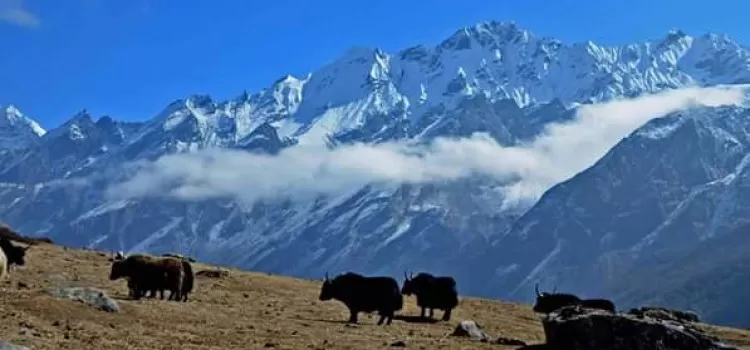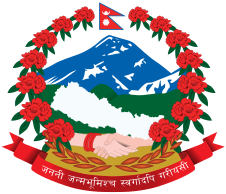Where is the Mount Everest located in the World

Where is Mount Everest located in the world? Nepal is a Himalayan country located between the great country of China to the north and India to the south. The roof of the world, “EVEREST,” exactly in between the Subrange of Mahalangur, the borderline of Nepal and Tibet, is 27°59’ North latitude and 86°55’ East longitude in the southern part of Asia. The political map of Nepal lists Mt. Everest in ward number 4 of Khumjung Village Development Committee of Solukhumbu District in the Sagarmatha National Park. Kathmandu is the nation’s capital and largest city of Nepal.
Mount Everest is known by different local names; the Nepalese call it “Sagarmatha,” which refers to the forehead in the sky. Likewise, the Tibetan language is called ‘Chomolungma,' meaning Mother of the World. Before the name given as Everest, it was called the Third Pole. The peak is named “EVEREST,” derived from the land surveyor general, Sir George Everest, who was the first person to locate the exact position of the mountain. In order to acknowledge his achievement, the British government decided to honor the name Everest as the name of the peak, although George Everest was always rather embarrassed by the honor.
On 29 May 1953, Tenzing Norgay Sherpa from Nepal and Edmund Hillary from New Zealand became the first climbers who reach the summit of Mount Everest. Both of them were passionate mountaineers and explorers. Before their successful summit, there were many attempts that failed by the many British expedition teams. But people never get desperate. Still, annually, thousands of climbers attempt to summit Everest; some become fortunate, and some lose their lives in the lap of the Himalayas. To climb the Everest, one must have prior experience and technical knowledge about rope, the use of an ice ax, tent management, emergency survival techniques, etc. There are two main expedition routes, one approaching the summit from the southeast in Nepal (known as the “standard route”) and the other from the north in Tibet. Altogether, 45 minutes to two months are required to conquer the whole expedition on the Everest.
Quick facts about the EVEREST
- The highest peak in the world—8848meters / 29,029 feet
- In 1921, the First attempt by the British Expedition
- The first successful summit was on May 29, 1953, by Sir Edmund Hillary of New Zealand and Tenzing Norgay, a Sherpa from Nepal. They climbed from the south side on a British expedition led by Colonel John Hunt.
- Apa Sherpa, “Super Sherpa,” is the first person to have successfully summited the top of the world. The first victory was in 1990, and his last time to the summit was in 2011.
- The first woman to summit Everest was Junko Tabei of Japan in 1975
- The youngest person to reach the summit was American Jordan Romero, age 13 years 11 months, on May 23, 2010, from the north side.
- The oldest person to the summit was Japanese Miura Yiuchiro, age 80, on May 23, 2013
- The first climbers to summit Everest without bottled oxygen were Italian Reinhold Messner and Peter Habler in 1978. He is also the first climber to ascend all fourteen peaks over 8,000 meters (26,000 ft) above sea level.
Everest climbing is an extreme adventure activity. Those who are not physically fit for the expedition in the Everest region don’t need to worry. Himalayan Smile operates amazing Everest Base Camp trekking that offers the closest view of the highest peak, Mount Everest, right in front of your eyes. The trekking packages include a trekking permit, a 25-minute scenic flight, guides, posters, and other necessary equipment. The trip can be customized as per preference.
Land of the Himalayas—the Mount Everest region is one of the richest regions in terms of nature and culture. Including the Everest, many towering panoramic views greet each traveler throughout the seasons. Mainly, two seasons are known as the peak season to trek: spring (February, March, April) and autumn (September, October, November), although trekkers can do trekking in any season within their favorable time constraints. Everest consists of some of the fabulous Himalayas, which are Mt. Lhotse (8,516 m / 24,940 ft), Mt. Nuptse (7,855 m / 25,772 ft), Amadablam (6,812 m / 22,480 ft), Kangtenga (6,782 m / 22,380 ft), Thamserku (6,623 m / 21,855 ft), Kwangde (6,011 m / 19,837 ft), Kusum Kanguru (6,373 m / 21,030 ft), holy Mt. Khumbi-la (5,761 m / 19,012 ft), Island peak etc. Additionally, Sherpa villages, their unique cultural diversity, and hospitality are also synonymous with Everest trekking.
Everest Base Camp in Nepal is one of the most popular treks in Nepal. Each year, thousands of trekkers visit this region. Technically, no equipment or skills are required, but you need to be able to deal with a mountain attitude. The beginners need to take an extra day for proper acclimatization. The Everest base camp trek generally starts with a 35-minute scenic flight from Kathmandu to Khumbu Airport at Lukla. Namche Bazaar is known as the capital of the Khumbu region; here you find every piece of equipment, good things, accommodation, and hospital facilities. The highest point in this trek is 5545 m at Kalapather; here you hike in the morning. And you retrace your trek back to Lukla via Gorak Shep. Trekking at high altitude can cause acute mountain sickness (headache, dizziness, loss of appetite) because when you trek higher elevations, gradually the amount of oxygen will be thinner and thinner. So that you cannot walk properly. Ignoring AMS is very hazardous. It might be the cause of death. The best solution for AMS is to trek down and down towards the lower elevation.
The World’s 14 Highest Mountain Peaks (above 8,000 meters)
In the world, only 14 peaks are above 8000 m above sea level. Mostly, the Himalayas are located in the Asian region. The world’s 8 tallest out of 14 peaks are in Nepal, including the world’s highest peak, Mt. Everest. According to EverestNews.com, only 17 climbers have reached the summits of all 14 peaks. The following are the world’s highest mountains listed below:
- Mount Everest (29,029 feet / 8,848 meters)—Nepal
- Mt. K2 (28,251 Feet, 8,611 meters)—Pakistan
- Mt. Kangchenjunga (28,169 feet/8,586 meters)—Nepal
- Mt. Lhotse (27,940 feet/8,516 meters)—Nepal
- Mt. Makalu (27,838 feet/8,485 meters)—Nepal
- Mt. Cho Oyu (26,864 feet/8,188 meters)—Nepal
- Mt. Dhaulagiri I (26,795 feet)—Nepal
- Mt. Manaslu (26,781 feet/8,163 meters)—Nepal
- Mt. Nanga Parbat (26,660 feet/8,126 meters)—Pakistan
- Mt.Annapurna I (26,545 feet, 8,091 meters)—Nepal
- Gasherbrum I (26,470 feet / 8,068 meters) – Pakistan
- Broad Peak (26,400 feet / 8,047 meters)—Pakistan
- Gasherbrum (26,360 feet / 8,035 meters)—Pakistan
- Chisapangba (26,289 feet / 8,068 meters)—China


.png)
.png)






